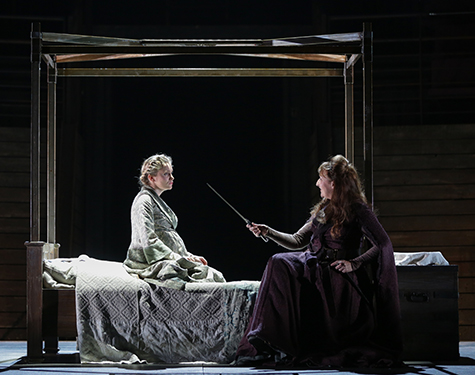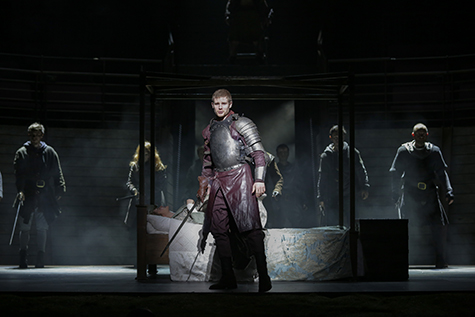A sad bunch of lonely kings
Ben Brooker: The James Plays Trilogy

The James Plays Trilogy, Adelaide Festival 2016
photo Russell Millard
The James Plays Trilogy, Adelaide Festival 2016
The James Plays Trilogy, a cycle of historical dramas written by Rona Munro and directed by National Theatre of Scotland Artistic Director Laurie Sansom, like Socìetas Raffaello Sanzio’s Go Down, Moses assays the nature of complex inheritances from a distant time populated by beings that feel (at least superficially) like our psychological kin. The plays, first performed in Edinburgh in 2014, dramatise three generations of Stuart kings, variously enthusiastic presiders over a feudal, fragmented 15th century Scotland.
In the first, The Key Will Keep the Lock, James I (Steven Miller) returns to Scotland after 18 years of detention in an English prison to an impoverished nation beset by factionalism. His long exile and bookishness make him the subject of suspicion (“what sort of a king is brought up reading books and writing poetry?”) but his dutifulness and patriotism—he quickly marries Joan Beaufort (Rosemary Boyle), daughter of the 1st Earl of Somerset and decries the financial rapaciousness of the English—win grudging respect in a volatile parliament (though not enough, of course, to prevent his assassination).
In the second play, The Day of the Innocents, James I’s heir (Daniel Cahill, in place of an injured Andrew Rothney)—known as Little Red Face on account of a conspicuous birthmark—becomes King of Scots at just six years of age. Acutely aware of his tumultuous inheritance (“I have dark blood like snakes under my skin”), the boy is plagued by nightmares and seeks respite through friendship with an older boy, William, the future Earl of Douglas. Douglas’ powerful family, however, led by the mercurial Balvenie (Peter Forbes), has designs on the throne, an ambition unlikely to be jeopardised by an infantile king driven to hide in a box, fearful of fulfilling his dark fate. “You’ll grow to be a monster,” James is warned. In this world—where “God can take our lives in an hour, in a minute,” as John (Ali Craig) puts it in the third play—survival, let alone success, demands it.
The cycle is completed by The True Mirror, the longest of the three plays, in which the flamboyant James III (Matthew Pidgeon) leads a parliament increasingly ill-at-ease with his profligacy—he wants £60,000 to visit the cathedral at Amiens for inspiration for the European-style court of his fantasies and a choir (“just forty or so”) to follow him everywhere, so as to “cushion every moment with something beautiful.” The Queen, the prudent Margaret of Denmark (Malin Crépin), begins to steady the ship of state by taking control of the court’s finances. “This whole country,” she tells him, “is like a house we’re trying to hold together with our bare hands.” The King’s excesses, both fiscal and sexual (he takes a mistress, the first to appear in the trilogy, and has dalliances with numerous men), take on paranoid (“I’ve long suspected I’ve been surrounded by liars”) and, finally, hubristic dimensions.
The first play is the slightest of the three, reducing the courtship of James I and Joan Beaufort to pure soap opera; for the most part, the machinations of 15th century Scottish feudalism are little more than a suitably alien backdrop for comedy over-dependent on fish out of water-isms. Four nooses that overhang the stage during the first scene prove to be a red herring, presaging only Munro’s consistent difficulty in organically working up tension out of the drama. The Day of the Innocents is a significant improvement, in that it at least has an absorbing character arc at its centre, as is the final play, the most stylistically diverse of the three, which introduces some invigorating contemporary accents in Jon Bausor’s otherwise firmly period costume design, and which sees a commanding performance from Pidgeon as James III. The trilogy as a whole (able to be viewed in Adelaide in a single sitting, albeit with multiple meal breaks) benefits from a strong ensemble.

The James Plays Trilogy, Adelaide Festival 2016
photo Russell Millard
The James Plays Trilogy, Adelaide Festival 2016
The texts themselves are problematic, tending towards the blandly expository. Munro and Sansom seem so frightened by the idea of a single audience member losing track of events for even a moment that everything is spelt out to the letter in the manner of a crude ledger. The result is staidness, a flattening absence of intrigue or subtext and unwelcome recourse to ‘edgy’ language and soap operatics to artificially enliven proceedings. In contrast to the plays’ publicity, their nearest TV counterpart isn’t Game of Thrones or House of Cards, both fine exemplars of long-form cable TV drama, but the soapy Tudors.
As with that series’ creator, Michael Hirst, Munro has been upfront about taking significant liberties with the historical record—perfectly admissible in the name of populist entertainment—but the real problem is the paucity of psychological depth. Few, if any, of these characters seem motivated by anything except generalised longings for sex or power, and none, until we meet James III in the final play, The True Mirror, exhibits a compelling personality flaw. Death comes and goes, usually offstage or antiseptically stylised, with few aftershocks. However cheap human life may have been in the 15th century, it’s strange, and ultimately distancing, that grief and guilt—those mighty catalysts of Shakespearean tragedy—are here in short supply.
The only theme to really emerge over the trilogy is the loneliness of governance (“the king has no friends”) but its treatment is insufficiently nuanced to prove insightful. Its claim to contemporary resonance is staked, mainly, on Munro’s use of demotic language, but there is little in the way of universality here: these plays may usefully synopsise a neglected period of history but no amount of colloquialisms, however tunefully rendered, can disguise their essentially hermetic concerns (initial reviews picked up on the trilogy’s timeliness in light of the then-current referendum on Scottish independence, but even that localised reverberation has already died away).
It can all, perhaps, best be summed up in the centerpiece of Bausor’s set: a gargantuan sword embedded, Excalibur-like, into the stage. For such an overwrought statement, it’s surprising how quickly you forget it’s there.
–
Adelaide Festival of Arts 2016, National Theatre of Scotland, National Theatre of Great Britain, Edinburgh International Festival, The James Plays, writer Rona Munro, director Laurie Sansom, design Jon Bausor, lighting Philip Gladwell, Adelaide Festival Theatre, 26 Feb-1 March
RealTime issue #131 Feb-March 2016, web






